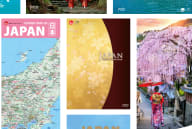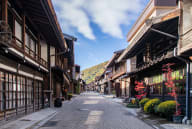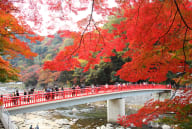
What if your first temple experience puts you off for 30 years?
My initial experience of Zazen meditation — the term for seated meditation in Zen Buddhism — was not a happy one. On my first trip to Kyoto, a Japanese friend suggested I attend a sitting with him at a small temple on the city’s eastern outskirts. The meditation began shortly after dawn, in a cold damp room looking onto an austere garden. A tall monk entered. My friend had told me he was so adept at meditation, that he could breathe in through his nose and expel that same breath through his anus. Studying his severe face and puckered mouth, I wondered if he did not sometimes reverse the process.
Before proper meditation began he devoted a lot of time to rearranging my limbs as the others, all Japanese, pretended not to watch. I already knew how to do full lotus position — each ankle on the thigh of the opposite leg — but apparently not the right one. Breathing heavily, he laboured to make my feet lie flat, but they kept popping up, like rabbit ears. The third meditator to my right stifled a snicker. Finally the monk arranged me into a half lotus and went on to try to get my hands right.
Seating himself behind us, he clapped two wood blocks together three times and we began. After an hour or so — well, probably seven minutes — I thought I was doing rather well, keeping my eyes unfocused, my breathing prolonged, valiantly trying not to think about either sex or shopping — when I realized the monk was creeping along behind us, a sturdy walking stick in hand. When he got to me he thwacked my lower back hard with it, which had the desired effect of making me sit up straight, but also put me off Zazen for the next 30 years.
KYOTO REDUX
Flash forward to contemporary Kyoto and a small 16th-century Buddhist temple called Shunko-in, located within the sprawling Myoshin-ji Temple complex on the western outskirts of the ancient capital. Belonging to the Rinzai school of Zen Buddhism, Myoshin-ji is so venerable and its offerings so vast that locals sometimes refer to it as the “department store” of Zen Buddhism.
Shunko-in’s vice-abbot and director of international affairs, Reverend Takafumi Kawakami, greets me at the entrance to this small temple, a smiling bearish young man who speaks English with a pronounced American accent. After a brief tour of the premises — a long gallery with shoji screens open to reveal an oblong stone, sand and shrub garden, ceremonial rooms decorated with gilded murals of seated sages, soaring herons and gnarled trees — we adjourn to the meditation room.
With two large windows looking onto a more densely planted garden, the room has a single row of rounded blue cushions and a selection of chairs pushed up against one wall. Kawakami shows us how to sit but counsels that visitors should feel free to use a chair if they find the cushions uncomfortable. He also notes that “seated meditation” is more a posture of the mind than of the body — you can meditate standing up, walking or lying down as well. Emphasizing recent neurological and other scientific research into the effects of meditation on both the body and the mind, he adds, “A lot of people think that meditation is about emptying the mind, but how would we ever do that? Meditation is more about getting rid of subjectivity. We cannot stop thought, but if we concentrate on our breathing, we can detach ourselves from it.” One technique for doing this, he adds, is to think of ourselves in the third person as we meditate.
Lighting a stick of incense, he taps two blocks of wood together then taps a bell that resounds like a tuning fork, its vibrations quivering long on the air. As I gaze out the window I begin to narrate the story of my own meditation: “He sits on his cushion. He wishes he’d peed earlier. He can’t seem to focus. He’s still thinking about sex. How long is he going to have to do this? Fifteen minutes? Two hours? Why didn’t the vice-abbot say? He doesn’t think it’s fair to leave it open-ended like that. He wonders what his life would be like if there were less distraction. If he were a calmer, more focused person. He wonders what his life would be like if he came to live in a small serene temple like this one…”
When the bell sounds again, it startles me and I realize that I have been off somewhere else, a softer, quieter and entirely more pleasant place, without noticing I’d gone. The other meditators look as startled as I am.
We adjourn to a windowless room furnished with low tables. A young kimonoed woman brings us maple-glazed cookies and bowls of fragrant frothy green tea. Backlit by sunlight coming through a wall of shoji screens, Kawakami talks about how forward-thinking North American corporations send their workers here to learn meditation. He notes that it’s possible to stay in the temple’s guesthouse, a handful of Japanese-style rooms with private baths, free Wi-Fi and a communal kitchen. And no curfew! So my meditation fantasies about living in a temple could be realized.
In addition to being internationally known for its personalized Zazen instruction, Shunko-in is famous for being the first Buddhist temple in Japan to offer same-sex wedding ceremonies. Kawakami married a lesbian couple in 2010 and has performed four similar ceremonies since. When I ask why he decided to do this, he smiles and says, “To quote your new prime minister, it’s 2015.”
About the writer
Will Aitken is a Montreal-based travel and arts journalist. His work has appeared in enRoute, Globe & Mail, Elle Canada, National Post, Maclean's and a variety of other publications. He also has worked as a writer-broadcaster for the CBC, TVOntario, the BBC and NPR and has published three novels: Realia, A Visit Home and Terre Haute. His book about Italian filmmaker Luchino Visconti - A Candle to My Shames: The Venetian Films of Luchino Visconti - was published in 2011. He has also taught multimedia production, film studies, English literature and classics at Concordia University, McGill University and Dawson College and has been a guest curator at Harvard University's Film Archives.
The opinions expressed in the above article do not reflect the views of JNTO. All content and images are property of the writer unless otherwise specified.
*This article is based on the writer's experience before COVID-19.




































































